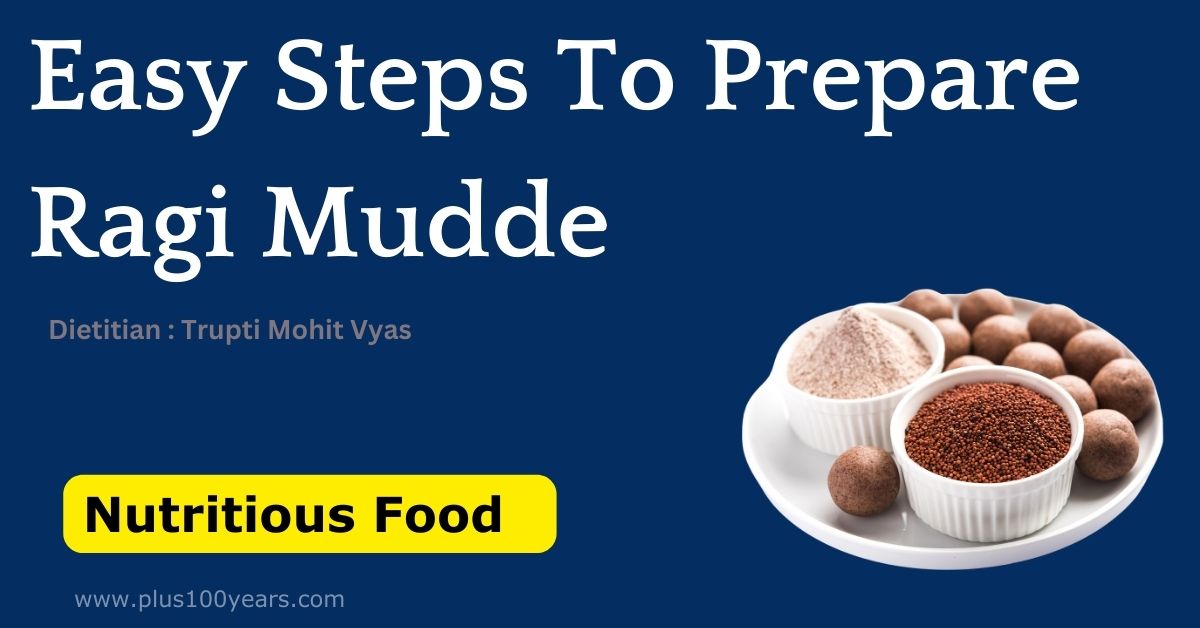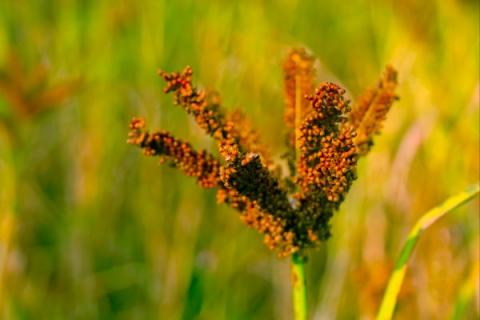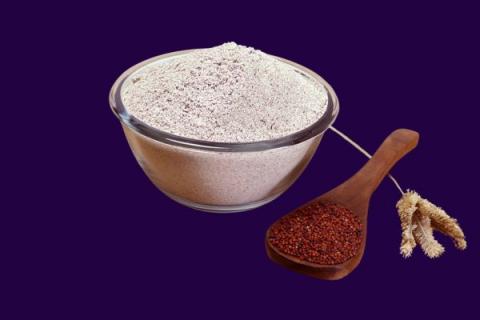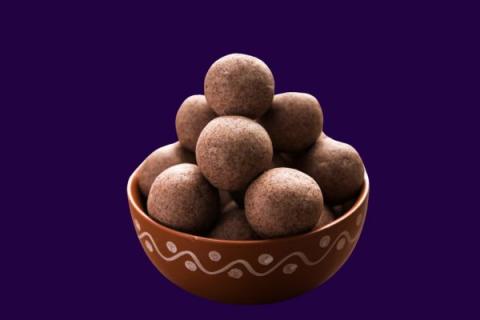
Updated: 17-03-2024
Author : Dietitian: Trupthi Mohit Vyas
Overall, ragi mudde is a nutritious and delicious addition to most diets. It's a good source of complex carbohydrates, fiber, iron, calcium, and other essential minerals.
However, if you have any concerns about potential side effects or interactions with medications, it's always best to consult with a healthcare professional before incorporating it regularly into your meals.

Ragi Mudde: A Quick and Easy Guide
Ragi mudde, the South Indian powerhouse, doesn't have to be time-consuming. Here's a simplified version of the recipe that gets you delicious mudde balls in no time:
Ingredients:
- 1 cup ragi flour (finger millet flour)
- 1 ¾ cups boiling water (adjust based on flour quality)
- ¼ teaspoon salt
- ½ teaspoon ghee (clarified butter) (optional)exclamation

Equipment:
- Stove
- Bowl (big enough to hold all ingredients)
- Whisk
- Fork
- Plate
- Bowl of water
Instructions
- Make a slurry: In a small bowl, whisk together 1 tablespoon of ragi flour with 3 tablespoons of water to form a smooth, lump-free slurry. Set this aside.
- Bring water to a boil: In a heavy-bottomed pot or pan, heat the remaining 1 ¾ cups of water with salt and ghee (if using) over medium heat. Bring it to a rolling boil.
- Incorporate the slurry: Slowly pour the ragi flour slurry into the boiling water while continuously stirring. This will help prevent lumps from forming.
- Cook until thick: Increase the heat slightly and keep stirring until the mixture thickens and becomes glossy. This takes about 2-3 minutes.
- Add remaining flour: Reduce the heat to low. Slowly add the remaining ragi flour, while continuously stirring with a whisk or wooden spoon. Don't worry if you see some small specks or loose lumps at this stage.
- Cook until smooth: Keep stirring and cooking on low heat for about 5-7 minutes. The dough should start to come together and become smooth. Scrape down the sides of the pan to ensure even cooking.
- Rest and shape: Remove the pan from the heat, cover it with a lid, and let it rest for 5 minutes. This allows the dough to absorb any remaining moisture.
- Form balls: Wet your hands slightly to prevent sticking. Take small portions of the dough and roll them into smooth balls.

2 Easy Tips To Prepare Ragi Mudde
Water Wisdom: If the dough feels dry after microwaving, add a tablespoon of hot water at a time and mix it well before forming the mudde balls.
Lumpy Love: Don't stress too much about a few small lumps. They tend to disappear as you form the mudde balls.
More About Ragi Millet
Ragi millet is often called finger millet. It is popularly known as a nutritious grain with amazing health benefits.
Nutritional Values of Ragi Millets:
|
Nutritional Component |
Value |
|
Energy |
320Kcal |
|
Protein |
7g |
|
Carbohydrates |
67g |
|
Dietary fibre |
11g |
|
Calcium |
364 mg |
|
Iron |
4.62 mg |
Top 5 Benefits Of Ragi Millets
- The gluten-free nature of ragi helps with celiac disease or gluten sensitivity.
- A low glycemic index from ragi aids in diabetes management and regulating blood sugar levels.
- Calcium present in ragi helps in bone strength and teeth.
- Zinc and iron present in ragi promote hair growth.
- Antioxidants present in ragi protect skin from free radical damage.
Enjoy Your Quick Creation!
Serve your freshly made ragi mudde with your favorite accompaniments and savor the taste of this healthy South Indian dish in no time!
Nutritional Facts In Ragi Mudde
Ragi mudde packs a powerful nutritional punch thanks to its key ingredient, finger millet. Here's a breakdown of the estimated nutritional value per 100 grams (approximately 3.5 ounces) of ragi mudde
- Calories: Around 160-200 calories. This varies depending on the amount of ghee used and the water content.
- Carbohydrates: Approximately 70-75 grams. Ragi mudde is a good source of complex carbohydrates, providing sustained energy.
- Protein: Around 3-5 grams. While not the most protein-rich food, ragi mudde contributes to overall protein intake.
- Fat: 1-3 grams. The fat content is primarily healthy fats, with some contribution from ghee (if used).
- Dietary Fiber: A significant amount, ranging from 10-15 grams. This promotes digestive health and keeps you feeling fuller for longer.
- Iron: A good source of iron, with estimates around 2-4 milligrams per 100 grams. This can be beneficial for those prone to iron deficiency anemia.
- Calcium: Ragi mudde shines here, boasting an impressive 300-350 milligrams of calcium per 100 grams. This makes it a valuable dietary source for strong bones and teeth.
- Other Minerals: Ragi mudde also contains essential minerals like potassium, magnesium, and phosphorus, contributing to overall well-being.
Important Considerations About Ragi Balls
- These are estimated values and can vary slightly depending on the specific recipe, ingredients used, and brand of ragi flour.
- If you use additional ingredients like vegetables or different types of chutneys with your ragi mudde, the overall nutritional profile will change accordingly.
- It's important to note that finger millet contains phytic acid, which can hinder the absorption of certain minerals like zinc and iron. Soaking or sprouting the ragi flour before cooking can help reduce phytic acid content and improve nutrient bioavailability.
Ragi Mudde: Pros and Cons
Ragi mudde, the South Indian powerhouse dish, offers a wealth of nutritional benefits. But like any food, it has its own set of considerations.
Here's a breakdown of the pros and cons to help you decide if Ragi Mudde deserves a spot on your plate.
Advantages of Ragi Mudde:
- Nutritional Powerhouse: Ragi mudde is packed with essential nutrients like calcium, iron, and dietary fiber. This translates to stronger bones, improved blood sugar management, better digestion, and boosted energy levels.
- Gluten-Free Goodness: For those with gluten intolerance, ragi mudde is a lifesaver. Finger millet, the base ingredient, is naturally gluten-free, making it a safe and delicious dietary choice.
- Weight Management Ally: The high fiber content in ragi mudde keeps you feeling fuller for longer, aiding in weight management efforts.
- Excellent Source of Iron: Ragi mudde is a natural remedy for iron deficiency anemia. The readily absorbable iron content combats fatigue and improves overall well-being.
- Rich in Calcium: Ragi mudde boasts impressive calcium levels, crucial for strong bones and teeth, particularly beneficial for growing children, pregnant women, and those prone to osteoporosis.
- Versatility in the Kitchen: Ragi mudde can be enjoyed plain or dressed up with various accompaniments. It can be paired with sambar, chutney, ghee, or even vegetables for a complete meal.
Disadvantages with Ragi Mudde:
- Potential for Gas and Bloating: While rich in fiber, ragi mudde can cause gas and bloating in some individuals, especially those not accustomed to high-fiber diets. Introducing it gradually into your diet can help mitigate this.
- Goitrogenic Effect: Ragi mudde contains goitrogenic compounds, which can interfere with thyroid function in individuals with existing thyroid conditions. Consultation with a doctor is recommended before consuming ragi mudde if you have thyroid issues.
- Phytic Acid Content: Finger millet contains phytic acid, which can hinder the absorption of certain minerals like zinc and iron. Soaking or sprouting the ragi flour before cooking can help reduce phytic acid content.
- Can be Time-Consuming to Prepare: Mastering the art of making ragi mudde takes practice. The process of whisking and cooking the dough can be slightly time-consuming compared to simpler dishes.
Overall:
Ragi mudde is a nutritious and delicious addition to most diets.
However, if you have any concerns about potential side effects, it's always best to consult with a healthcare professional before incorporating it regularly into your meals.

Add new comment